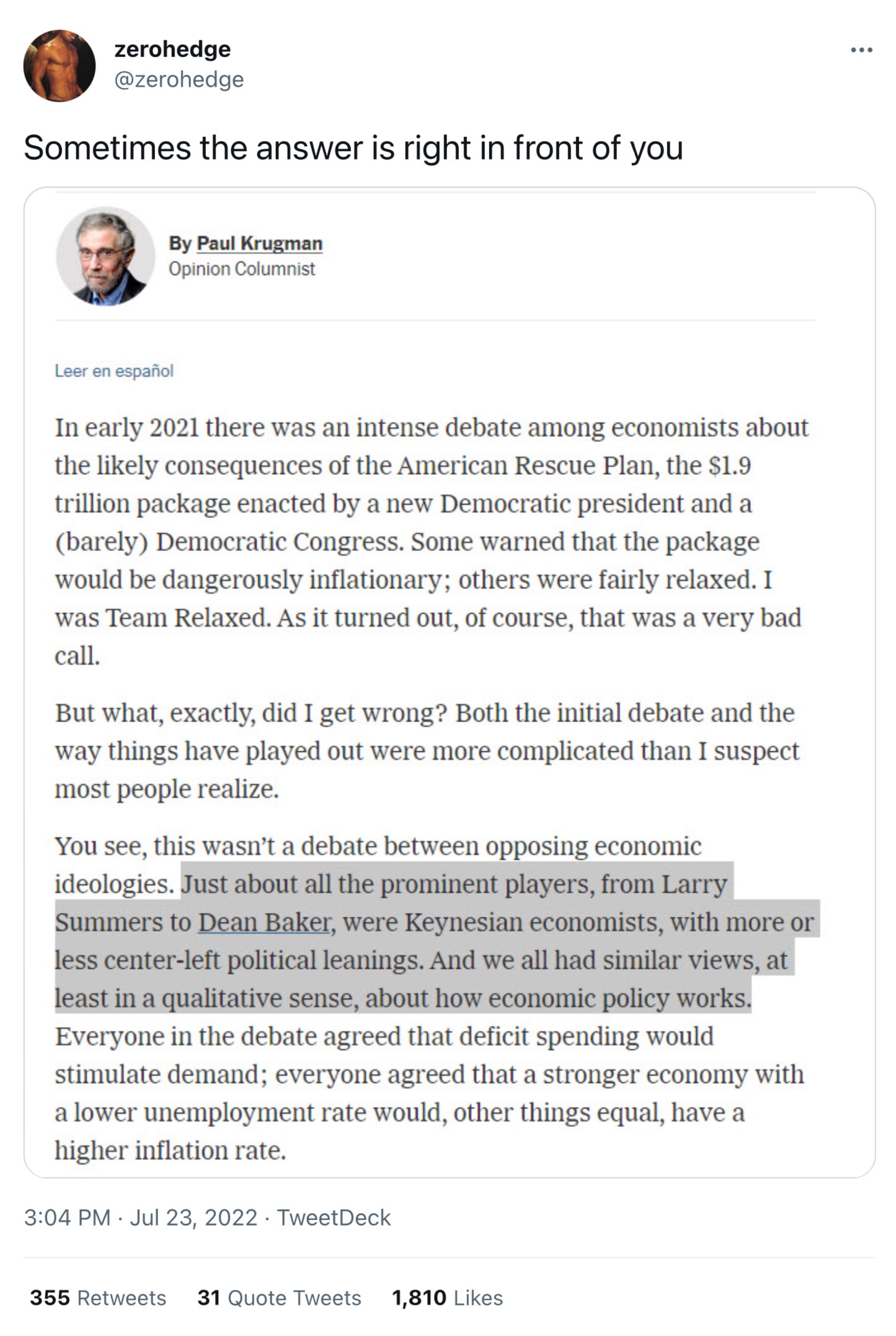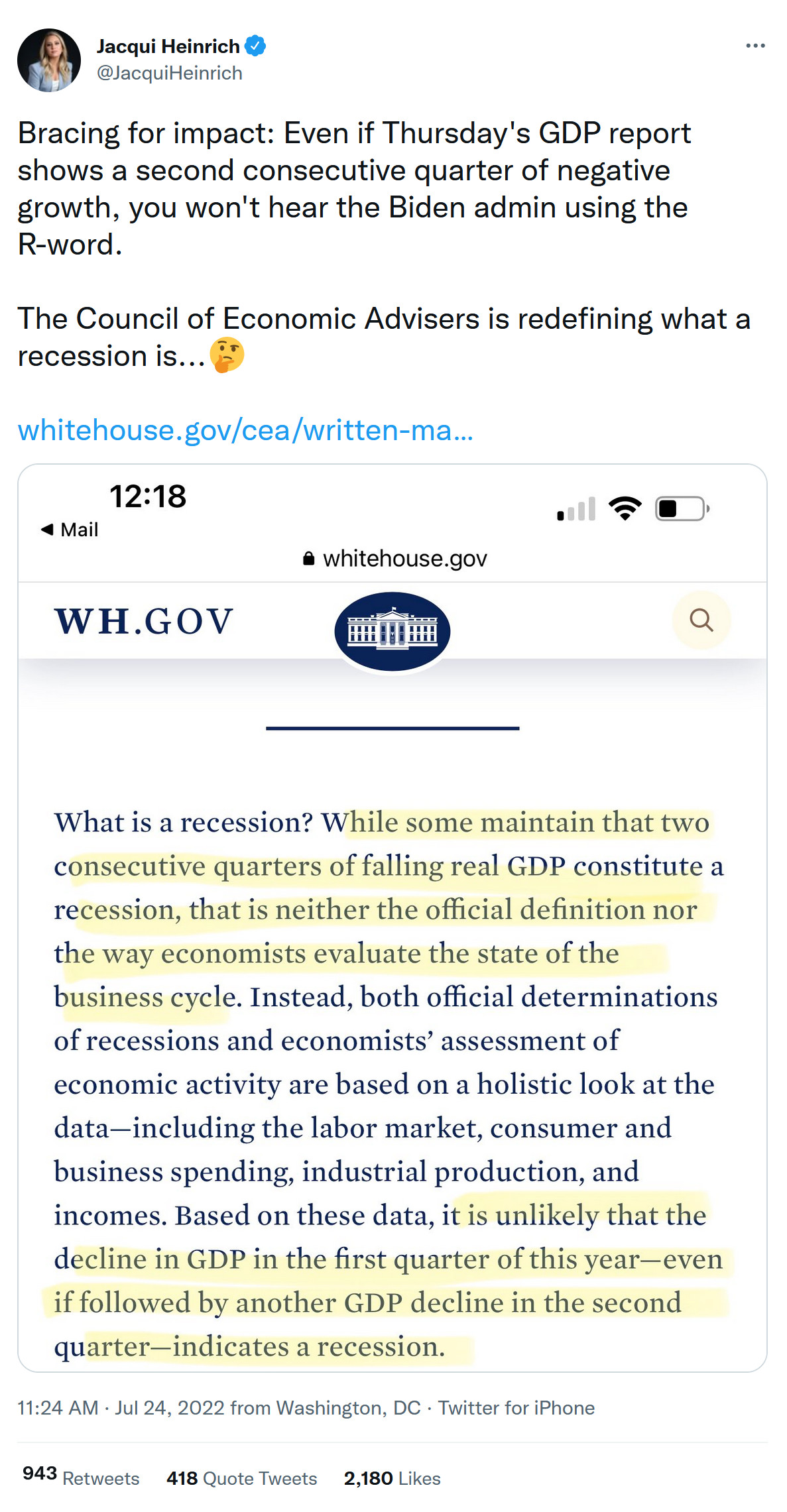OPEN THREAD: It’s all you.
Archive for 2022
July 24, 2022
THE NEW SPACE RACE: China could shift to fully reusable super heavy-launcher in wake of Starship.
IT’S SUMMER RERUN SEASON AT MSNBC: ‘Battle Stations!’: MSNBC Analyst Says If Republicans Win They’ll Cancel Elections, Impeach Biden Weekly.
Flashbacks:
● Fiona Hill: ‘Democracy is done’ if Trump is reelected.
—MSNBC, October 8th, 2021.
● Jeff Daniels Rips GOP On MSNBC: If Donald Trump Gets Re-Elected, “It’s The End Of Democracy.”
—IMDB News, May 20th, 2019.
HOW THE MEDIA POLARIZED US: The shift from ad revenue to the pursuit of digital subscriptions has turned journalism into post-journalism.
What comes next for the media industry? The validation of disturbing news within certain value systems has finally become a viable business model. But this business model has stratified the press, bringing meaningful results only to large, nationally concerned media outlets. News validation creates a swarming effect: people want to have disturbing news validated by an authoritative notary with a greater followership. Audiences want to pay only for flagship media, such as the New York Times or the Washington Post. If other, smaller media outlets don’t join the chorus, they risk digital backlash; if they do join it, they struggle to differentiate themselves and lack authority to be a recognized news validator, anyway. Most subscription money flows to a few behemoths. The new subscription model has led not only to media polarization but also to media concentration.
The biggest loss, however, is the mutation of journalism into post-journalism. The death of those newspapers that shut down before this mutation was at least honorable. Journalism wanted its picture to fit the world. Post-journalism wants the world to fit its picture, which is a definition of propaganda. Post-journalism has turned the media into the crowdfunded Ministries of Truth. The worst part for journalists is that only a few enterprises can succeed in this new business model. The worst part for society is that all legacy media need to pursue digital subscriptions or viewership as their last hope for survival, and thus must join the race of post-journalism.
A temptation always exists to blame media bias on a closely held conspiracy, but the real drivers lie deeper. Creed and greed might fill the medium with the messages, but it is the medium itself that defines polarization—its true message. If ad-driven media manufactured consent, reader-driven media manufacture anger. If ad-driven media served consumerism, reader-driven media serve polarization. There can be no “solution” for a shift of such magnitude. “How do we fix polarization?” is the wrong question. The right question is, “How are we going to live with it?”
Read the whole thing.
PREDICTION: BODYBUILDERS WILL BE THE FIRST TO USE THIS. Hibernating Bears Have a Secret Superpower Hiding in Their Blood. “If we humans tried to lie dormant for as long as a black bear, our muscles would begin wasting away from the sheer lack of physical activity. But when a bear emerges from its den at the start of spring, it stretches out a lean and strong body. The creature’s muscle mass and strength are largely maintained from the year before, despite little to no movement, not even to drink or eat, poop or pee.”
NEWS YOU CAN USE: Bananas may improve heart health, especially for women.
THIS IS ALL PART OF THE CALIFORNIA FREEDOM THAT GAVIN NEWSOM IS TOUTING THESE DAYS: US states divided over petrol stations as L.A. considers ban on new pumps.
As is this: Federal judge temporarily blocks BART from evicting Berkeley homeless encampment.
UPDATE: From America’s Newspaper of Record: 10 Biggest Adjustments Fleeing Californians Have To Make In Their New States.
I’LL TAKE “SUMMER” FOR $500, ALEX: Explainer: What is behind the heat waves affecting the United States?
YEAH, THAT’S A REAL POSER: How Should Martha Stewart Keep Coyotes Away From Her Pretty Birds?
WELL, THERE’S A SOLID FOUNDATION FOR THAT MISTRUST: Historical mistrust in government, health care industry contributes to COVID-19 vaccine hesitancy for African Americans.
GOODER AND HARDER, NEW YORK: Thefts of Catalytic Converters Have Quadrupled in New York City This Year.
BOTTOM STORY OF THE DAY: Liz Cheney reiterates she hasn’t decided on running for president in 2024.
ENOUGH ALREADY, BRING ME A REAL MENU: Against Restaurant QR Codes.
“MILTON FRIEDMAN ISN’T RUNNING THE SHOW ANYMORE:” Biden Administration Bracing for a Tsunami of Bad Economic News Next Week.
Politico calls the coming avalanche of bad economic news a “Category 5 storm.” Indeed, the Biden administration may want to dig a hole and hide while Biden goes to his summer home in Delaware, given the depressing numbers that will come out of Washington this coming week.
Consumer confidence numbers (which currently stink) hit on Tuesday. A Federal Reserve meeting and decision on interest rates, coupled with a press conference from Fed Chair Jerome Powell, follows up on Wednesday.
The first reading on second quarter economic growth drops on Thursday. And the latest numbers on our vexing run of historically high consumer price inflation close out the monster run of data on Friday. In a note to clients today, analysts at Deutsche Bank suggested the flood of information will “leave you breathless.”
Yikes.
For the White House, hope springs eternal. The administration has been touting the dropping price of a gallon of gas this month as if they’re reading the entrails of a newt and discovering that “prosperity is just around the corner,” as Herbert Hoover claimed right before the bottom dropped out of the economy.
But what are those newt entrails really telling us?
If only leading economists could have predicted the bad news:

UPDATE: Ahead of Expected Dismal Economic Data, White House Seeks to Redefine ‘Recession.’

Post-Reagan, recessions have a tendency to be politicized. The National Bureau of Economic Research redefined their recession definition to move the recession back from the third quarter of 2008 to December of 2007. Similarly, in the fall of 1992, the media hid the economic recovery occurring under George H.W. Bush’s watch to enable the Clintons’ “Worst recession in 50 years” lie. Or as a Time magazine headline writer described it with maximum self-satisfied snark on December 7th of 1992, “Bush’s Economic Present for Clinton.” The economy would grow 4.2 percent that quarter, but you never would have known it from the DNC-MSM until after November 3rd.
(Updated and bumped.)
I EAT CANNIBALS: Will Cannibalism In Culture Change The Unthinkable Into The Acceptable?
On July 23rd, the NY Times ran an article discussing the rise of cannibalism in popular American culture called A Taste for Cannibalism? The article covered the claim, “A spate of recent stomach-churning books, TV shows, and films suggests we’ve never looked so delicious — to one another.” Did the Times publish that article to protect Biden? Eating your neighbor is now popular, so you don’t have to worry about the supply chain crises or Bidenflation.
The Times started out by giving examples of the many books, movies, and TV shows using people eating as part of their plot lines. Not one of those examples of modern culture uses Sheb Wooley’s classic “purple people eater.” Nor did the NY Times story mention the Broadway musical hit from 1979 about cannibalism called Sweeney Todd: The Demon Barber of Fleet Street.
The “Old Grey Lady” listed the yummy people media and asked the question, “Can you stomach it?” In a rare move, the NY Times didn’t find a way to blame the trend on conservatives.
Classical reference in headline:
STAY COOL: BLACK+DECKER 14,000 BTU Portable Air Conditioner with Remote Control, White. #CommissionEarned
I AGREE: Uvalde Residents Want Consequences For Those Whose Failures Cost So Many Lives.
We need a new tort, “failure to protect,” that punishes gross failures on the part of law enforcement.
EVERYTHING IS GOING SWIMMINGLY: Jill Biden heckled in Connecticut: ‘Your husband’s the worst president we’ve ever had.’ Sadly, it’s true.
“A man was clearly angered over gas prices and wanted Jill Biden to know. Jill Biden was in Connecticut as part of a three-state trip focused on summer learning. The heckling incident happened as Biden and Education Secretary Miguel Cardona exited an SUV and entered a building in New Haven. . . . ‘Your husband is the worst president we ever had. You owe us gas money,’ an unnamed man yelled at her during the exchange.'”
READER FAVORITE: Alpha Grillers Instant Read Meat Thermometer for Grill and Cooking. #CommissionEarned
STEVE MORSE TO STEP AWAY FROM DEEP PURPLE PERMANENTLY: BAND PAY TRIBUTE. Morse says it’s impossible to commit to Deep Purple’s future plans as he looks after his wife, who is battling cancer: “I simply must be there with her.”
HE’S SUPER-CEREAL ABOUT GLOBAL WARMING: Al Gore Compares ‘Climate Deniers’ to Uvalde Police Officers.
WHY ARE ECO-PROTESTORS TRYING TO STOP A BICYCLE RACE? Tour de France fans take justice into their own hands and tackle militant eco-protesters before dragging them off the road to stop them blocking the race.
